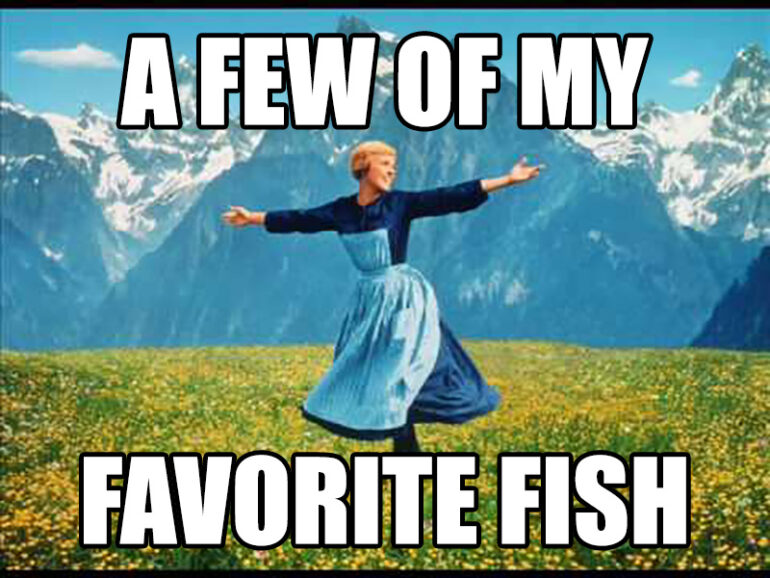This time of year when they play “These are a few of my favorite things”, and I am in the Christmas mood I thought I would list some of my favorite fish. Besides just listing them, I would also loke to share why they are my favorites. You may disagree, not see how they could be favorites or not care, but thinking about them made me realize they are favorites not because they are the most beautiful or rare, but because there is a story with each.
When I was compiling my list I tried to come up with the reason why they should make the list and why they are special to me. Hopefully once you read this you will consider adding them to your own tank or realize that they may not be worth it.
The first fish that is one of my favorites is the Orchid Dottyback, Pseudochromis fridmani from the Red Sea. What is not to like about this fish: it is vividly colored, hardy, of a reasonable size, not overly aggressive, relatively inexpensive and readily available. This is all true, but this was not always the case.
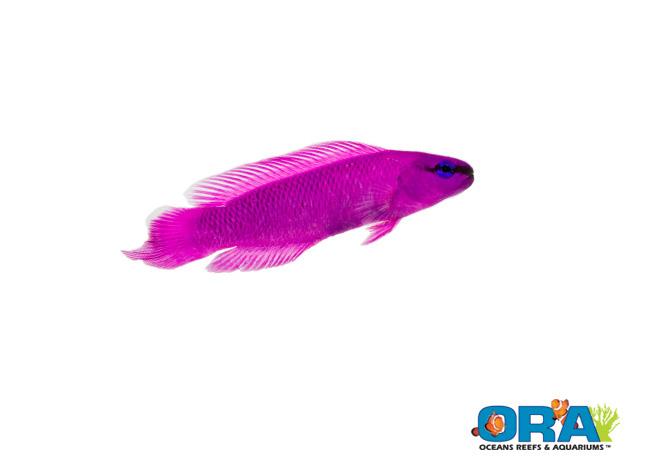
I fell in love with this fish when I saw my first one in a dealer’s tank in the late 1980’s. Unlike the fish we see today which are now mostly commercially bred, this fish was wild caught from the Red Sea. As a result, it was a rarity, not because it was difficult to find in the Red Sea, quite the contrary, but that at that time shipments from the Red Sea were few and far between and as a result when a gem like this came in collectors scooped it up quickly.
Living in Pittsburgh, not really the hub for getting rare fish first, made it even more difficult. For these reasons it took me over five years to finally get my hands on a pair of them. But looking back it was worth it. I say that as unlike many of the captive bred fish of today, the wild caught fish were even more vividly colored than most of the fish I see today.
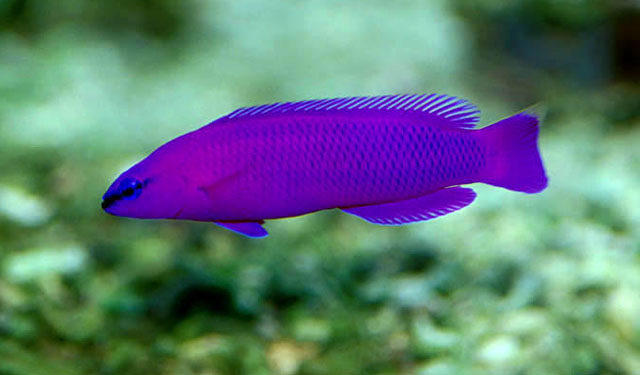
It may seem like an exaggeration but the wild caught fish looked so purple that to some they were actually blinding. This may seem impossible, but those fish’s colors were so bright because each scale was edged in blue. Sadly, when I looked at the captive bred pair that I now have I do not see this edging to their scales. So while I still love these fish, they just simply are not as colorful as the fish I remember.
One last thing I should note, that I wrote about these fish and my search for them in a SeaScope article in the 1990’s and our own Jake Adams said it is one of the first articles he read, and one of the articles that got him interested in the rare fish side of the hobby.
Just as I remember my obsession with finding an Orchid Dottyback, I similarly remember the first time I came across a Fairy Wrasse. In late 1996, while I was visiting friends I went to Quality Marines and came across a small brightly colored fish that I had never seen before.
It’s head was maroon/red, its body kind of orange gold and it tail and much of its lower fins were purple. I had never seen anything like it. Not only did I not know what it was, but no one there did either. It had come in as a miscellaneous wrasse. In those days, lots of fish came in a miscellaneous, as they were uncommon so most people did not know their names, especially the collectors and shippers and if you were lucky and knew someone you could often walk away with steals like this fish, which turned out to be a male, a Rosy Scales fairy wrasse.
As soon as I saw it I knew I had to have it, and it actually was quite reasonably priced at $19. So that was not the problem, the problem was I was not going directly home from there, but instead was going to San Francisco for three days after visiting there to give a talk. So the problem was, could I keep it alive while I was there. In those days you could bring a bag of fish on a plane with little hassle. So I took the chance and had the fish bagged, in an extra large bag, and brought it in my checked luggage up to san Francisco with me.
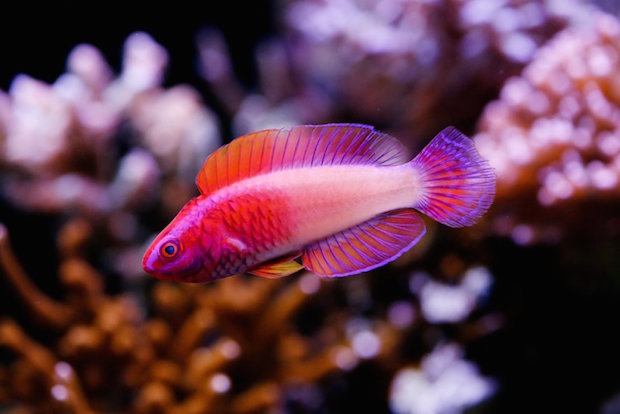
Fortunately, I was giving a talk to the Marine Society of San Francisco, who were more than happy to help me out by allowing me to do water changes of my fish’s water daily as I tooled around and saw their tanks. As I remember, Bob Mankin, Greg Cook and Francesca Guertsma were all helpful in helping me keep my rare charge alive by bringing clean water from their tanks so I could keep my fish alive.
Obviously this fish was pretty hardy to go through this and make it back with me to Pittsburgh. As I mentioned this was the first Fairy wrasse I had seen let alone kept, but it proved to be hardy when I placed it in my tank as well. It ate well and did quite well in my tank for well over a year. Then I learned my other lesson about Fairy Wrasses, they are jumpers so unfortunately after all that I lost him when he jumped through a small space I stupidly left at the top of my tank. Despite this mistake I have kept several of these beautiful fish over the years and they all make me recall the first one I found.
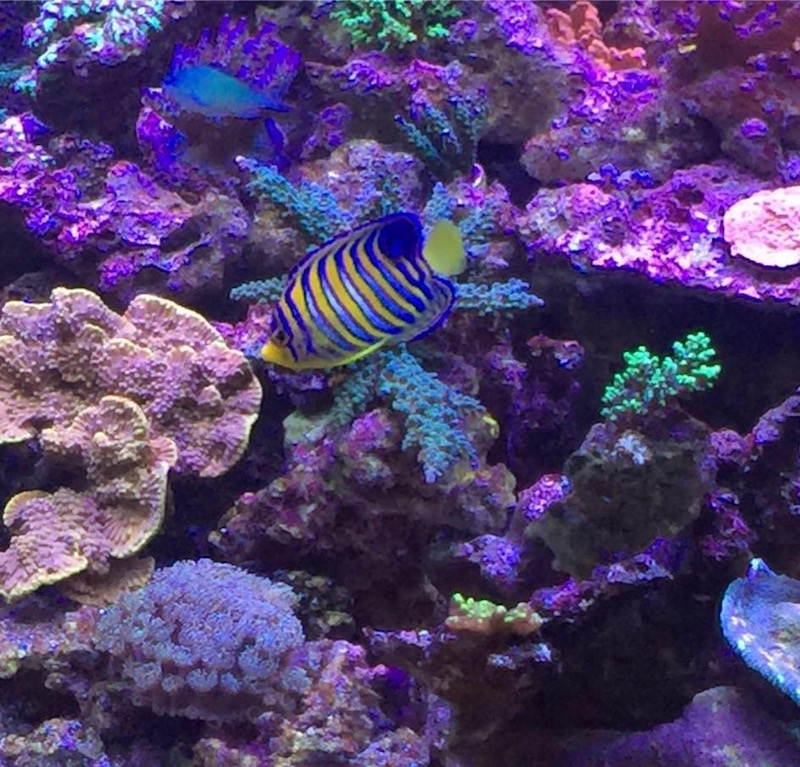
While the first two fish may seem relatively common unexciting and easy to keep, my next favorite fish is one that is one of my favorites because it is still relatively uncommon, it is spectacularly colored and it has been and still is often difficult to acclimate and keep. While there are a lot of angelfish, and I have kept my share of them, my favorite among them is still the Red Sea Regal Angel, Pygoplites diacanthus, that I have now had in my tanks for almost 15 years.
Regal angels are notorious as being difficult to keep and this one was no exception. I found it in a dealer’s tank where it was not eating and where if it was left it was certain to die. I did not hold out a lot of hope that I could save it, but even emaciated it was still quite striking so I thought it was willing to try and save. But truth be told I was not that confident so when I bought it, I made a deal with the shop that if it died within a month I would get my money back, which even then was a tidy sum of almost $200.

When I got it home I decided that the only way it would survive was if I gave it a tank of it’s own, where it would be the king of the tank and where I could hopefully get it to feed with no interference from aggressive tankmates. This was actually one of the first times I set up a special quarantine tank for a new fish, as yes like many of us I apparently like the thrill of taking a chance that a new fish isn’t going to wipe out our entire tank.
But this fish was worth the extra effort in my mind. So I put it into an extra forty-gallon tank that I connected to my then 1200-gallon tank. I then put in lots of live rock from the sump of the big tank and started to try and get it to eat. One of the things I have learned over the years is that not every fish eats everything or just one thing so as a result I keep a lot of different foods for feeding my fish on hand.
I would love to say that this fish ate the first or even second thing that I put into its tank, but sadly it did not eat any of the foods that I added to its tank. At least I did not see it eat any as I diligently observed it after every feeding, which I did multiple times each day. As a result, I was convinced that I had failed and that the fish was doomed to starve to death.
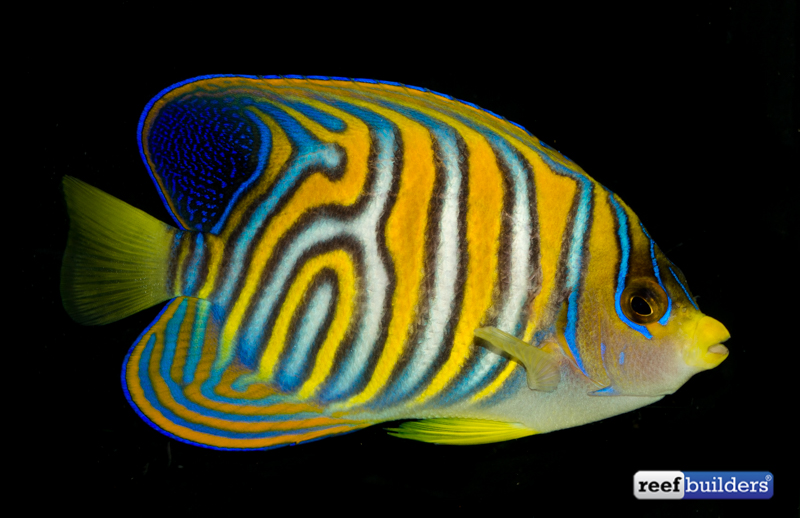
However, as I kept looking at it daily I noticed that at first it was not getting any thinner, and then it seemed to actually be filling out. I thought this was wishful thinking at first, but after a month it was still alive and obviously a little fatter than when I got it. But I watched it carefully every time I put food in, which I still continues to do frequently, and I never observed it eating, so how was this possible?
While sitting there one night before the lights went out when the room was dark I observed it picking aggressively at the live rock in the tank. It was the closest I had seen to it eating, but the question is what was it eating. The next day when I moved the live rock around it the answer became clear, the old live rock from the sump from the sump of the 1200 was full of sponges and that is what the angel was eating.
I stupidly had not done my homework on what the fish liked to eat, but I had lucked out by putting rock full of different sponges in it tank, which it happily ate and by feeding the tank so often I seemingly had helped the sponges to continue to grow and thus provided food for the angel. Once I saw that the angel liked to pick sponges from the rock, I started to put different foods into the rock and eventually got it to eat a variety of foods other than the sponges, with blackworms and bloodworms being two of its favorites.
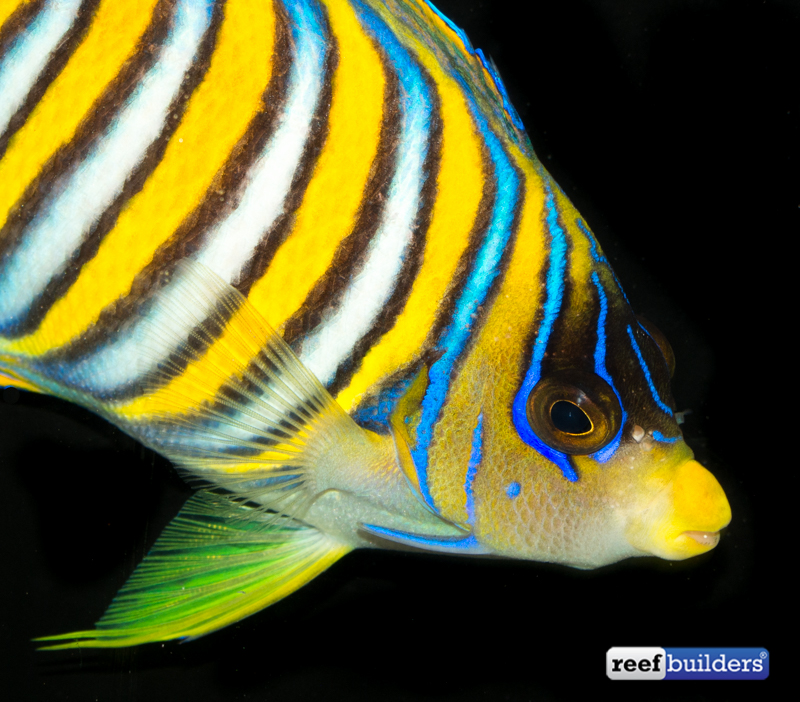 Once it had fattened up, which took almost a year, it was finally introduced into the 1200, where it thrived until I took the tank down and moved it to my current 300-gallon tank. I must admit that while the 1200 was up I got cocky and tried to get this fish a mate. As a result, after acclimating two other Red Sea Regal angels I introduced them the tank in the hopes of having a pair form. Sadly, this fish would have none of that and soon after each new angel was introduced it quickly harassed and killed the new fish.
Once it had fattened up, which took almost a year, it was finally introduced into the 1200, where it thrived until I took the tank down and moved it to my current 300-gallon tank. I must admit that while the 1200 was up I got cocky and tried to get this fish a mate. As a result, after acclimating two other Red Sea Regal angels I introduced them the tank in the hopes of having a pair form. Sadly, this fish would have none of that and soon after each new angel was introduced it quickly harassed and killed the new fish.
After failing twice, I have given up on finding it a mate and am now quite content to observe it as it darts among the caves and overhangs in its new tank. I would love to say that it is reef safe, but in its presence most meaty LPS have little chance, so if you want to keep it in a reef tank, I would advise against housing any meaty lps corals with it, but despite this, it is still a show stopper of a fish to keep in a sps dominated reef tank.
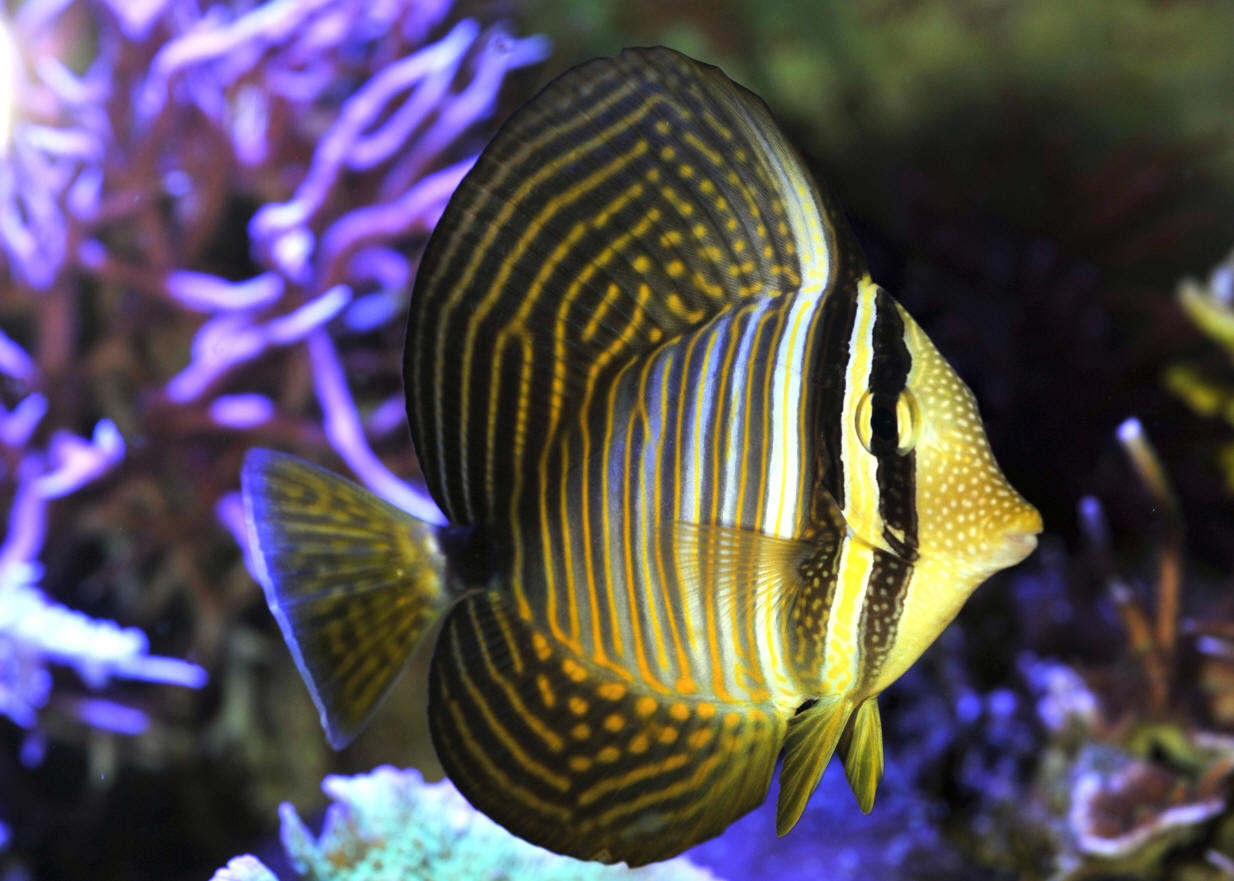 While the previous fish might have become favorites at least in part due to the difficulty I had finding them or acclimating them, my next favorite fish became a favorite due not only due to its beauty, but also because I have found that it performs a valuable function in every tank of mine that it is in. While a sailfin tang may not seem all that exotic, the fish that is one of my favorites is actually the Red Sea Sailfin tang, Zebrasoma desjardinii.
While the previous fish might have become favorites at least in part due to the difficulty I had finding them or acclimating them, my next favorite fish became a favorite due not only due to its beauty, but also because I have found that it performs a valuable function in every tank of mine that it is in. While a sailfin tang may not seem all that exotic, the fish that is one of my favorites is actually the Red Sea Sailfin tang, Zebrasoma desjardinii.
When I got my first one of these fish it was actually a small yellowing colored juvenile that was about as thin as a potato chip. After acclimating it and getting it used to picking at nori I introduced it to my 540-gallon sps tank where I was constantly having a Valonia algae problem. I am not sure exactly which species of Valonia it was, but seeminly in every crevice in the live rock small pockets of the lttle tiny pest were growing.
While I had tried several times to remove it, it always seemed to keep coming back. A couple of months after I introduced the tang I began to notice that the Valonia that had always been a pest was for some reason not as prevalent. And to be honest I had no idea why as I had not really changed any of my routines. However, I did notice that when I was working in the tank if I popped some of these little bubbles the tang instantly ate them up. Also over this time the tang had gone from a being really thin and shy to a much thicker robust fish with the typical beautiful coloration of this Red Sea/Indian Ocean fish.
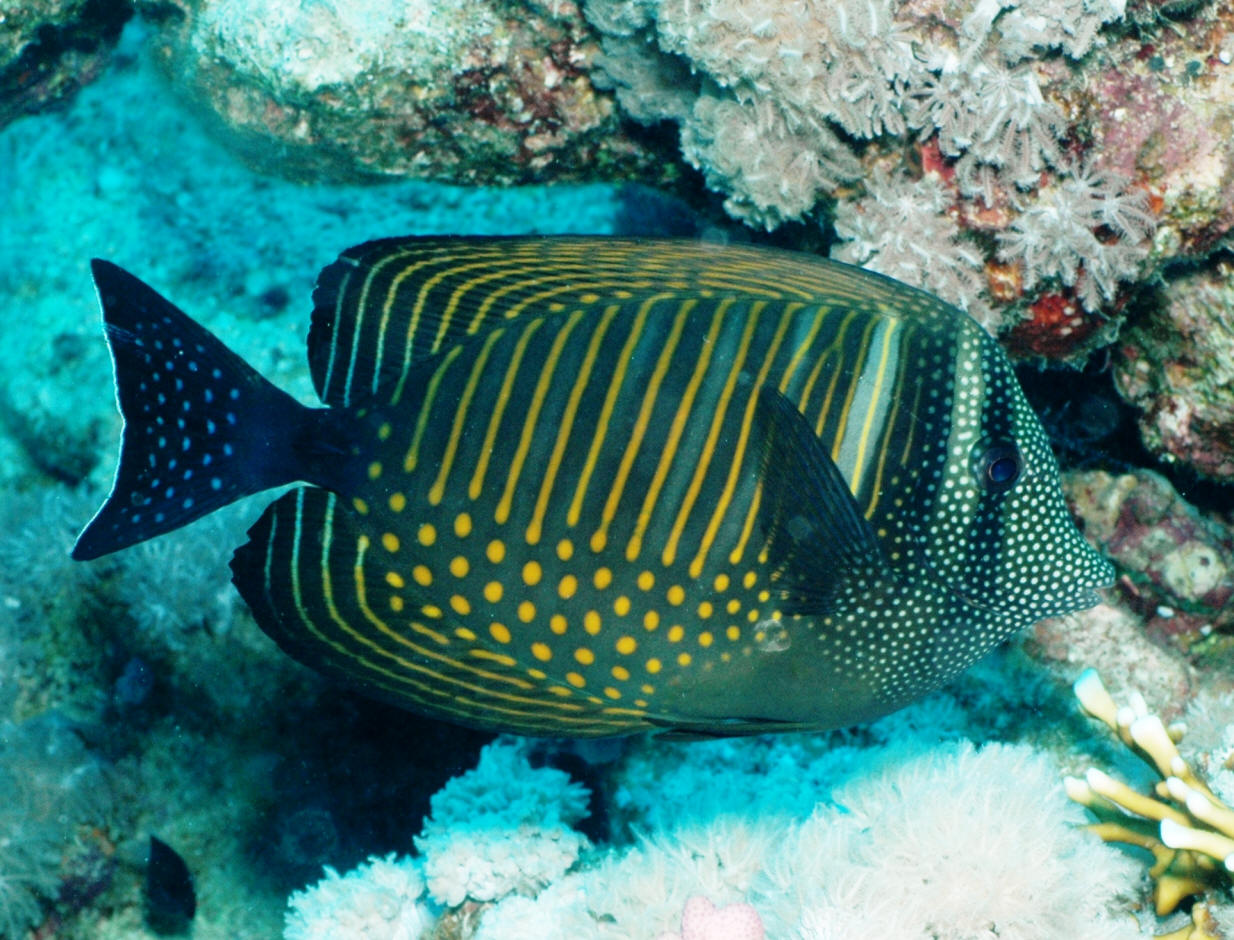
Needless to say the combination of this fish consuming Valonia along with great coloration and a strong personality are the reasons it is one of my favorites and why I have one in three of my tanks. I will add one caveat, and that is that in two of my tanks because of this fish there is not any Valonia anywhere, while in the third tank for some reason this fish has not been as interested in eating Valonia. So if you consider this fish just for that reason it is not a sure bet that it will be a Valonia vacuum.
One of the Holy Grail fish that are now somewhat more available, but at a heft price are Gem tangs. While I admit that the brown and white polka dot pattern is quite striking, I find it hard to justify spending at least $1000 or more to get one. This is especially the case when I have been keeping a fish with a similar color pattern for the last twenty years and the cost then and now for the fish is still usually under $100.

The fish I am talking about is the Marine Betta or Comet, Calloplesiops altivelis that has been an inhabitant of my tanks for now over 20 years. Part of the allure of this fish to me, is that unlike the Gem Tang, this fish is usually somewhat secretive preferring to stay in caves or overhangs rather than swimming constantly at the front of the tank with the other fish.
Because of this it is a favorite as when it suddenly pops out in the open, its wonderful color and full finnage make it a fish that you cannot take your eyes off of. I have these fish in two of my tanks, with one being over twenty years of age. The second one being in its own tank, is the result of my trying to pair these fish up, with the result being the older one quickly attacking and trying to kill the new one.
Seeing this was rather confusing as this fish usually moves rather slowly and from what I have seen is not a particularly efficient hunter. So when it suddenly darted out to meet the new fish and struck at it with speed I had never seen it exhibit before it finally demonstrated that this fish truly is related to its much more aggressive cousins the grouper.
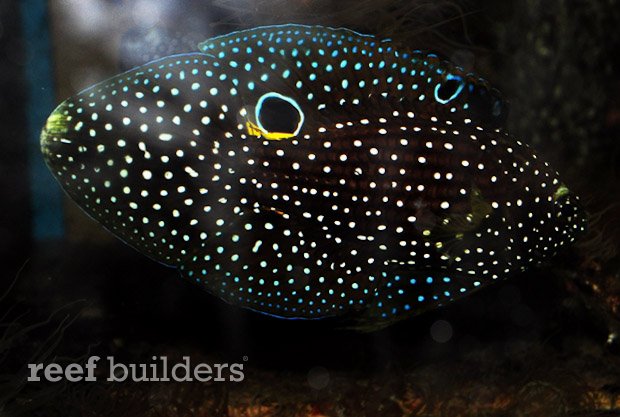
The one I have in my 300-gallon tank has been in my tanks for now over twenty years, which to me is amazing because as I noted I have not seen it to be especially adept at hunting or even competing with the other more aggressive fish in the tank for food. But somehow it has managed to stay alive with these fish in a 540, then 1200 and now 300-gallon tank with seemingly little stress.
When I moved it from the 1200 to the 300 I thought it had died as soon after I moved it I did not see it for over six months. Then miraculously one day it popped out of the rocks unexpectedly and has been coming out when the tank is fed ever since. So for a much cheaper colored version of a Gem Tang I can’t recommend this fish enough as for the most part it is also incredibly hardy.
All of my favorite fish so far are for the most part relatively easy to obtain and and might even be considered standard reef tank inhabitants for the most part. The last fish however, has only recently become available more frequently although it is still relatively rare and as a result is also expensive. If I had to pick a group of fish that are my favorites it is undoubtedly wrasses and hogfish.

And while I already highlighted my favorite fairy wrasse, I must admit that my Peppermint Hogfish, Bodianus opercularis, is probably even more of my favorite. This bright red and white striped elongated fish really is named appropriately as when it is happy it does resemble a peppermint stick or a candy cane. And unlike some of its wrasse cousins, it is quite robust and is virtually always out at the front of the tank. Unfortunately like some of its hogfish cousins, this fish does not tolerate other fish similar in shape or color, especially if they are introduced after it has become the dominant fish in the tank.
It is easy to feed and take care of as like its cousins it eats virtually anything including any decorative shrimp or crabs you might add to the tank as well as snails, mollusks or other tank cleaners. For these reasons you have to be careful as to what other fish or inverts that you house it with as well as when you introduce it, which should be after you add everything else.
But these factors are forgotten when you see this brilliantly colored fish patrolling your tank and picking any small inverts off of the rock. Unlike most of my tanks where the corals are the stars, in the tank that houses this fish, it really is the star of the tank. I also must admit that it is one of my favorites for another reason. I have had tanks in my house for almost my entire life and my dad has seen every tank go up and every fish or coral go in, and as long as I remember he never commented any of them.
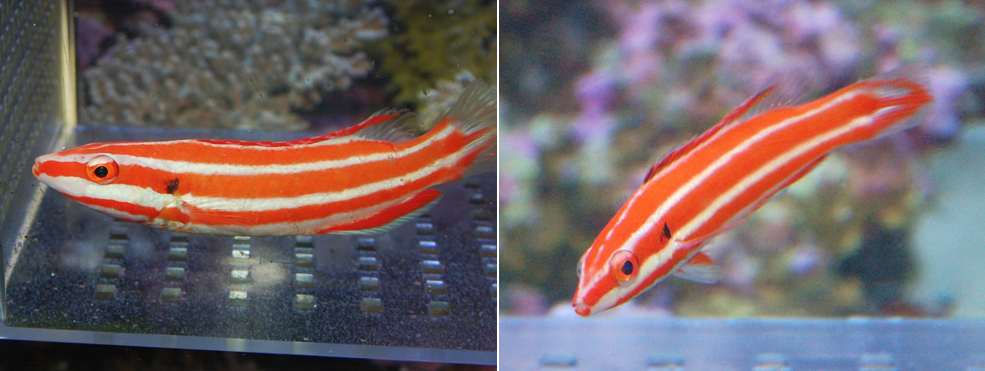 However, when I got this fish a few years ago and put it in the tank in my dining area one evening when I had my parents over for dinner he looked at the tank and commented that it was a really cool fish. So as much as I love this fish, knowing that my dad actually recognized a cool fish for the first time will make me always want to have one in my tanks.
However, when I got this fish a few years ago and put it in the tank in my dining area one evening when I had my parents over for dinner he looked at the tank and commented that it was a really cool fish. So as much as I love this fish, knowing that my dad actually recognized a cool fish for the first time will make me always want to have one in my tanks.
Looking in my tanks I currently have almost a hundred different species of fish in them and over the years I have had at least that number as well. So picking out some of my favorites has not been easy, especially since I have a soft spot for all of them. But as hopefully I have explained for different reasons I have a special spot for each of the fish I listed. And I will do think of them each as special, I still have never named them. My dog Lucie is the only pet in my house with a name.


